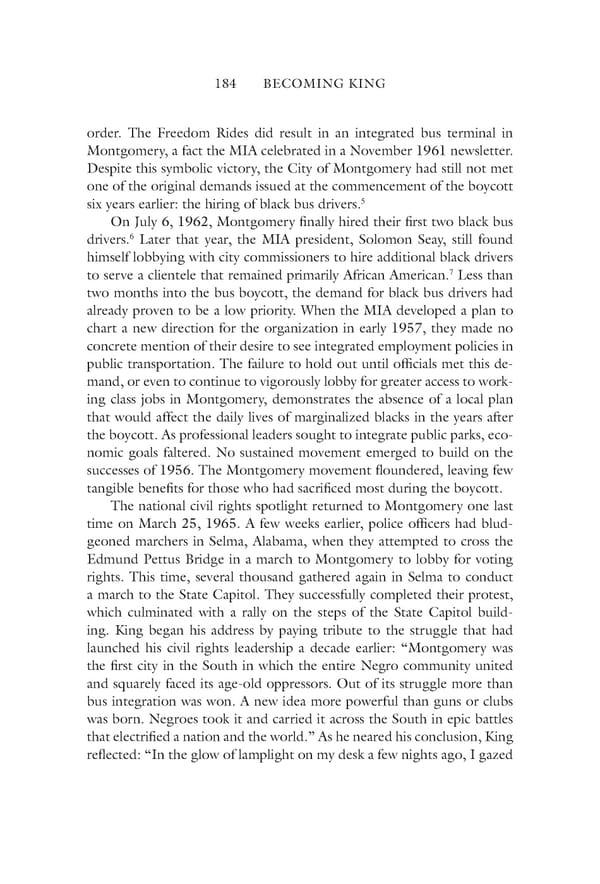184 BECOMING KING order. The Freedom Rides did result in an integrated bus terminal in Montgomery, a fact the MIA celebrated in a November 1961 newsletter. Despite this symbolic victory, the City of Montgomery had still not met one of the original demands issued at the commencement of the boycott 5 six years earlier: the hiring of black bus drivers. On July 6, 1962, Montgomery finally hired their first two black bus 6 drivers. Later that year, the MIA president, Solomon Seay, still found himself lobbying with city commissioners to hire additional black drivers 7 to serve a clientele that remained primarily African American. Less than two months into the bus boycott, the demand for black bus drivers had already proven to be a low priority. When the MIA developed a plan to chart a new direction for the organization in early 1957, they made no concrete mention of their desire to see integrated employment policies in public transportation. The failure to hold out until officials met this de- mand, or even to continue to vigorously lobby for greater access to work- ing class jobs in Montgomery, demonstrates the absence of a local plan that would affect the daily lives of marginalized blacks in the years after the boycott. As professional leaders sought to integrate public parks, eco- nomic goals faltered. No sustained movement emerged to build on the successes of 1956. The Montgomery movement floundered, leaving few tangible benefits for those who had sacrificed most during the boycott. The national civil rights spotlight returned to Montgomery one last time on March 25, 1965. A few weeks earlier, police officers had blud- geoned marchers in Selma, Alabama, when they attempted to cross the Edmund Pettus Bridge in a march to Montgomery to lobby for voting rights. This time, several thousand gathered again in Selma to conduct a march to the State Capitol. They successfully completed their protest, which culminated with a rally on the steps of the State Capitol build- ing. King began his address by paying tribute to the struggle that had launched his civil rights leadership a decade earlier: “Montgomery was the first city in the South in which the entire Negro community united and squarely faced its age-old oppressors. Out of its struggle more than bus integration was won. A new idea more powerful than guns or clubs was born. Negroes took it and carried it across the South in epic battles that electrified a nation and the world.” As he neared his conclusion, King reflected: “In the glow of lamplight on my desk a few nights ago, I gazed
 Becoming King: Martin Luther King Jr. Page 204 Page 206
Becoming King: Martin Luther King Jr. Page 204 Page 206